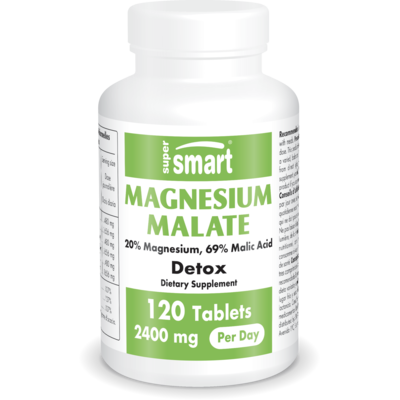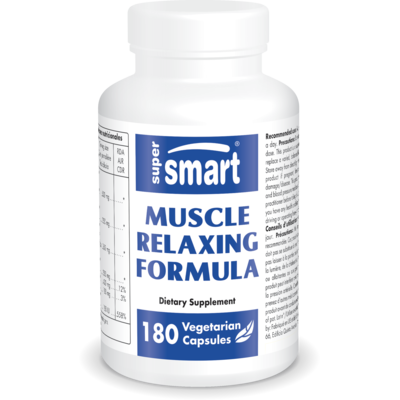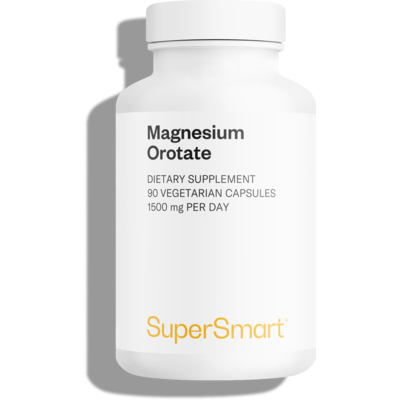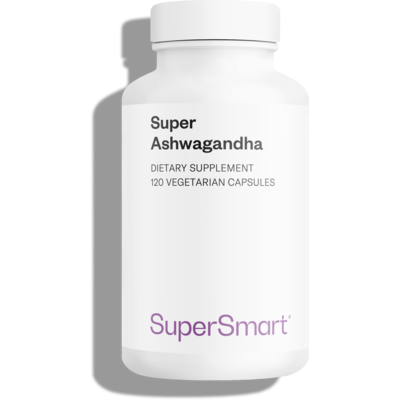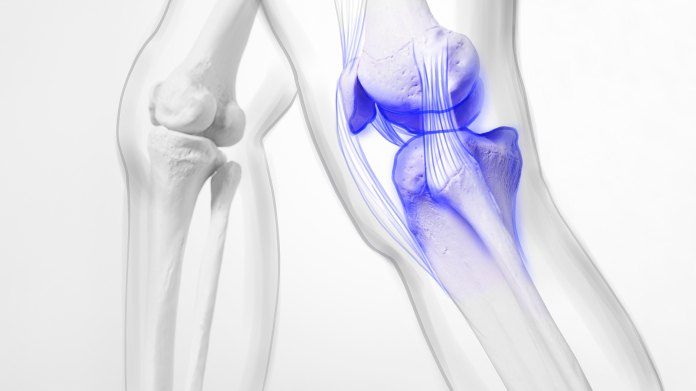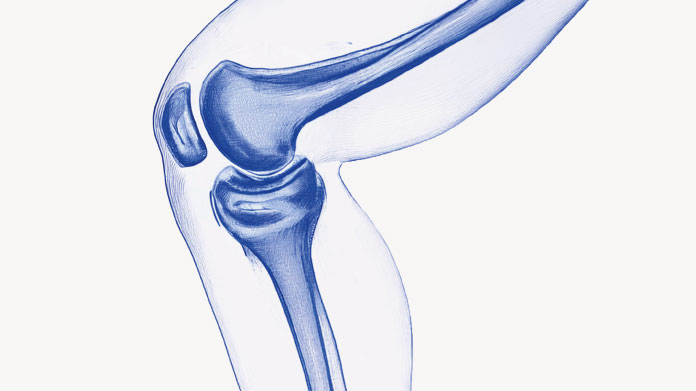The best natural muscle relaxants to relax your muscles
Contractures, cramps... What if natural muscle relaxants were the solution? Discover the best substances for gently relaxing your muscles.

Natural muscle relaxants: what are they?
The term ‘muscle relaxant’ refers to substances used to ease muscle tension or spasms.
These compounds reduce muscle tone, i.e. the basic tension of the muscles, by acting at various levels: directly on the striated fibres responsible for contractions, on the control of the motor neurons which excite these fibres, or at the nerve-muscle interface (neuromuscular junction).
Muscle relaxants are mainly used to relieve muscle contractures, particularly neck, lumbar or back pain, but also recurrent nocturnal cramps (1).
They form the basis of certain classes of anxiolytic drugs (benzodiazepines) and general anaesthetics used during surgery. They also occur naturally in certain plants or nutrients, where they exert a milder but still effective action.
The best natural muscle relaxants
Magnesium: a key mineral in neurotransmission
Magnesium is an essential mineral found in large quantities in the human body, mainly in bones and teeth, and plays a role in more than 300 distinct enzymatic reactions (2).
It is involved in cellular energy production, neurotransmission and muscle relaxation, and supports the normal functioning of the nervous system and muscles (3).
In our diet, magnesium is concentrated mainly in cocoa, nuts, wholegrain cereals and legumes.
The occurrence of tremors, numbness, muscle spasms or irregular heartbeats may suggest a deficiency (4).
It should be noted that people who are elderly, athletic, experiencing stress or undergoing diuretic treatment are more prone to deficiency: in these contexts, magnesium supplementation using highly bioavailable forms that are well tolerated by the digestive system (such as magnesium orotate from Magnesium Orotate, magnesium malate from Magnesium Malate, or the Multi Magnesium Formula synergy which combines 8 exceptional forms) is a relevant strategy (5-7).
Valerian: a nervous activity regulator
Also known as catnip, valerian (Valeriana officinalis) is a perennial herb of the Caprifoliaceae family which grows in damp soils in Europe and Asia.
Already praised for its thousand virtues by ancient authors such as Dioscorides and Hippocrates, its roots are used today in phytotherapy to regulate sleep disorders and support mental health (8).
More specifically, valerian is thought to have sedative and relaxing properties due to its sesquiterpene acids, which have been shown in vitro to have some affinity for GABA receptors (which help reduce nervous activity) (9).
It could therefore induce a state of calm conducive to muscle relaxation, which is why it is found in certain formulations dedicated to muscle relaxation (such as Muscle Relaxing Formula, which combines valerian with magnesium).
Ashwagandha: the relaxing plant of Ayurveda
The adaptogen family includes Indian ginseng, aka Ashwagandha (Withania somnifera). A long-established part of traditional Indian pharmacopoeia, this famous tonic of Ayurvedic medicine provides invaluable help during periods of nervous tension or anxiety.
By modulating the levels of certain neurotransmitters (such as GABA and serotonin) and the production of cortisol (the stress hormone), it is thought to contribute to optimal relaxation, physical and mental well-being and emotional balance — and, by extension, to support muscle relaxation (10-11).
Most of its benefits are currently attributed to its content of a group of steroidal lactones known as withanolides (which is why our Super Ashwagandha extract is precisely standardised to 5% withanolides).
Passionflower: reducing psychomotor agitation
Native to South America and Mexico, passionflower (Passiflora incarnata) is a climbing vine with spectacular flowers, whose aerial parts are traditionally used to relieve the physical manifestations of anxiety (12).
A unique combination of flavonoids, betacarbolines and maltol, it is thought to interfere with the GABAergic system to temper neuronal excitability, thereby inducing a state of calm by reducing psychomotor agitation (the cause of nervous, difficult-to-control movements that place excessive strain on muscle tissue) (13).
The WHO defines it as ‘a mild sedative effective against nervous agitation, insomnia and anxiety’, justifying its use in certain relaxation supplements (such as Muscle Relaxing Formula).
Synergistic formulas for muscle relaxation
Why opt for a muscle-relaxing synergistic formula?
As well as the undeniable convenience of an all-in-one supplement, this format draws its strength from the complementary nature of its compounds, chosen to cover all aspects of muscle relaxation and maximise their mutual effectiveness.
So you can imagine, for example, the benefits of a dietary supplement that combines valerian, passionflower and magnesium in a single capsule (as Muscle Relaxing Formula does).
SUPERSMART ADVICE
References
- Oldfield BJ, Gleeson B, Morford KL, Adams Z, Funaro MC, Becker WC, Merlin JS. Long-Term Use of Muscle Relaxant Medications for Chronic Pain: A Systematic Review. JAMA Netw Open. 2024 Sep 3;7(9):e2434835. doi: 10.1001/jamanetworkopen.2024.34835. PMID: 39298168; PMCID: PMC11413720.
- Allen MJ, Sharma S. Magnesium. [Updated 2023 Feb 20]. In: StatPearls [Internet]. Treasure Island (FL): StatPearls Publishing; 2025 Jan-. Available from: https://www.ncbi.nlm.nih.gov/books/NBK519036/
- Garrison SR, Korownyk CS, Kolber MR, Allan GM, Musini VM, Sekhon RK, Dugré N. Magnesium for skeletal muscle cramps. Cochrane Database Syst Rev. 2020 Sep 21;9(9):CD009402. doi: 10.1002/14651858.CD009402.pub3. PMID: 32956536; PMCID: PMC8094171.
- Kothari M, Wanjari A, Shaikh SM, Tantia P, Waghmare BV, Parepalli A, Hamdulay KF, Nelakuditi M. A Comprehensive Review on Understanding Magnesium Disorders: Pathophysiology, Clinical Manifestations, and Management Strategies. 2024 Sep 1;16(9):e68385. doi: 10.7759/cureus.68385. PMID: 39355467; PMCID: PMC11444808.
- Pickering G, Mazur A, Trousselard M, Bienkowski P, Yaltsewa N, Amessou M, Noah L, Pouteau E. Magnesium Status and Stress: The Vicious Circle Concept Revisited. 2020 Nov 28;12(12):3672. doi: 10.3390/nu12123672. PMID: 33260549; PMCID: PMC7761127.
- Bohl CH, Volpe SL. Magnesium and exercise. Crit Rev Food Sci Nutr. 2002;42(6):533-63. doi: 10.1080/20024091054247. PMID: 12487419.
- Classen HG. Magnesium orotate--experimental and clinical evidence. Rom J Intern Med. 2004;42(3):491-501. PMID: 16366126.
- Bent S, Padula A, Moore D, Patterson M, Mehling W. Valerian for sleep: a systematic review and meta-analysis. Am J Med. 2006 Dec;119(12):1005-12. doi: 10.1016/j.amjmed.2006.02.026. PMID: 17145239; PMCID: PMC4394901.
- Sahin K, Gencoglu H, Korkusuz AK, Orhan C, Aldatmaz İE, Erten F, Er B, Morde A, Padigaru M, Kilic E. Impact of a Novel Valerian Extract on Sleep Quality, Relaxation, and GABA/Serotonin Receptor Activity in a Murine Model. Antioxidants (Basel). 2024 May 27;13(6):657. doi: 10.3390/antiox13060657. PMID: 38929096; PMCID: PMC11200646.
- Majeed M, Nagabhushanam K, Mundkur L. A standardized Ashwagandha root extract alleviates stress, anxiety, and improves quality of life in healthy adults by modulating stress hormones: Results from a randomized, double-blind, placebo-controlled study. Medicine (Baltimore). 2023 Oct 13;102(41):e35521. doi: 10.1097/MD.0000000000035521. PMID: 37832082; PMCID: PMC10578737.
- Sprengel M, Laskowski R, Jost Z. Withania somnifera (Ashwagandha) supplementation: a review of its mechanisms, health benefits, and role in sports performance. Nutr Metab (Lond). 2025 Feb 5;22(1):9. doi: 10.1186/s12986-025-00902-7. PMID: 39910586; PMCID: PMC11800443.
- da Fonseca LR, Rodrigues RA, Ramos AS, da Cruz JD, Ferreira JLP, Silva JRA, Amaral ACF. Herbal Medicinal Products from Passiflora for Anxiety: An Unexploited Potential. 2020 Jul 20;2020:6598434. doi: 10.1155/2020/6598434. PMID: 32765195; PMCID: PMC7387951.
- Janda K, Wojtkowska K, Jakubczyk K, Antoniewicz J, Skonieczna-Żydecka K. Passiflora incarnata in Neuropsychiatric Disorders-A Systematic Review. Nutrients. 2020 Dec 19;12(12):3894. doi: 10.3390/nu12123894. PMID: 33352740; PMCID: PMC7766837.
Keywords
3 Days
Quick service
Quick service
MONELL
4 Days
Speedy service.
Speedy service.
ROSENTHAL Marvin
8 Days
Clear website- Efficient
Clear website. Excellent search engine and fast delivery!
Mohamad Hussein
10 Days
They have great products.
They have great products.
Vickie
10 Days
Great Shipping Time!
You Have A Great Shipping Time! Praise The Lord!
DMHoge
12 Days
Doctor Recommended!
Good pricing, very good availability, doctor recommended (couldn't find what I needed anywhere else), and it took only a week to arrive (which I can't complain about).
Al
13 Days
Great product and fast shipping
Great product and fast shipping
Marie
14 Days
New customer 1
I got my order fast and on time.
SA
14 Days
Great Service
Fast, good communication, as promised.
Juli
18 Days
Thrgood product website is easy to use and shipping…
Thr website is easy to use and shipping is very fast.
Richard Kienzle
19 Days
I like and recommend it!
I like and recommend it!
CRUZ Francisco
20 Days
Really like that they don’t have…
Really like that they don’t have fillers in their supplements. Great customer service and quality products
Becky E. Stiles
27 Days
Catalase.
Great catalase product.
John Yagi
38 Days
I always receive my products on time.
I always receive my products on time.
Kelly
43 Days
Fast service and good products
Fast service and good products
PERCY

